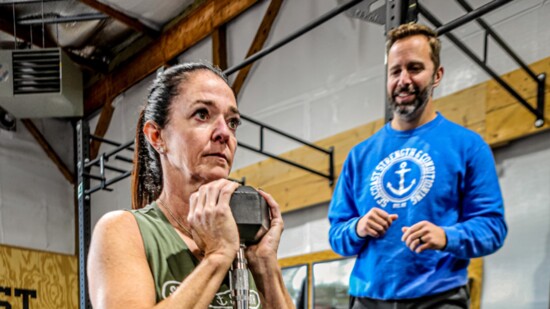Josh Gould, owner of Seacoast Strength & Conditioning, has created something comfortably New England with a no-frills, meticulously organized, warehouse-style space that needs nothing more than the power of its community of motivated clients and dedicated trainers to fill it.
Describe your journey from Boston to the Seacoast.
I studied exercise science and physiology at UMass-Lowell and spent 10 years in corporate fitness and private training, working with high-level professionals. I also freelanced as a public speaker and writer, promoting personal fitness.
Over time, my focus shifted from thinking about working for myself to what it means to build a business better than you are. I wanted to bring modern, science-based strength and conditioning education to the general public using an accessible group model. I was familiar with the area—my parents had relocated to Rye—so I started searching for the right location to establish a training business here. We found this spot, opened in 2016, and will add our new Kittery facility this winter.
How does group training work?
Training starts one-on-one but can then move to a semi-private model with a maximum ratio of 4 to 1, client to coach. In a single group session, you will find all backgrounds and ages, 85 to 10, because everything is individualized for each client. Friends and family members often join the same session, which helps to build community and accountability.
You mention 10-year-olds. What does your youth program look like?
For our younger clients, the focus is more on sports performance or filling the gaps in physical education. As they get older, many choose a single sport year-round as their focus, and the gym provides some balance to that sports training. For young athletes, it’s about building the gas pedal. For adults, it’s about building the brakes.
What shifts have you noticed in the mindset towards personal training?
The tides are turning. After years of focusing on thinness, the emphasis has moved to building strength, enhancing mobility, and improving bone density. While muscle development has long been a priority for men, more women now recognize the value of strength training for their long-term health and vitality.
How do you create a safe space here at the gym?
It’s an industry failure when people don’t feel comfortable in a gym. We work to counter people’s perceptions of working out. Social media is one way we reflect the diversity of our clients so that everyone can see themselves represented. Also, meeting people where they are is key to ensuring safety from pain, injury, and overexertion. We encourage first-timers to come and observe. Plus, the music’s not too loud.
What keeps clients coming back each day?
Results. We monitor clients’ progress using a naturally progressive training program and software that tracks performance and highlights development.
And community. We host monthly socials—like hikes, rock climbing, salsa lessons, or a lively line dancing event, which recently drew 30 members. For Thanksgiving, a fundraiser for Gather, let the top donor throw a pie in my face.
What does the lifecycle of personal training look like?
It’s forever. You can add intensity to get ready for a reunion or a wedding, but the idea is to come often and regularly to stay with it.
Lesli Friel, a longtime SSC client, describes her motivation.
I love the trainers here and the family environment. I am exponentially stronger than I was when I first started.
Pull Quote: I love the trainers here and the family environment. I am exponentially stronger than I was when I first started.
